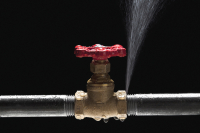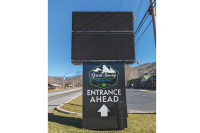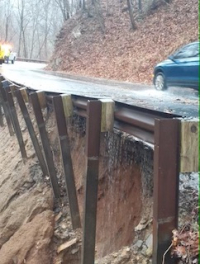EMS costs throw a wrench in Jackson budget talks
 Ambulance service in Jackson County could more than double in cost to taxpayers if commissioners decide to fund the full $1.4 million budget requested by Harris Regional Hospital.
Ambulance service in Jackson County could more than double in cost to taxpayers if commissioners decide to fund the full $1.4 million budget requested by Harris Regional Hospital.
Currently, Jackson provides $587,000 for Harris to run emergency 911 calls alongside the routine medical transport that Harris provides.
“As time has gone on some changes in cost structure have occurred, and we believe there are further changes in cost that will occur,” said Steve Heatherly, CEO of Harris.
The changes can be lumped into three categories, Heatherly said. Staff salary changes are the first, with pay raises having already gone into effect. Paramedics in Jackson were making far less than their peers in neighboring counties, Heatherly said, so in 2015 Harris bumped their pay to something more competitive. The 2015 budget numbers reflect that increased cost, but only partially because the raises didn’t take effect until the budget year was already underway.
The hospital has also been working to increase Emergency Medical Service staffing. They’ve already added two full-time positions — previously, EMS supervisors responded to calls like everyone else rather than giving their full attention to administrative duties. Hiring new people to take the two supervisors’ place on calls brings practices in Jackson more in line with surrounding counties, Heatherly said.
“These folks (paramedics) tend to work in multiple counties, so they were seeing that be the pattern in other area services, and we were probably a little bit behind the times,” he said.
Related Items
Harris also wants to add a new crew and truck in the Qualla area of Jackson County. A fully equipped ambulance costs between $165,000 and $170,000, and four new full-time positions would be required to provide service during the peak hours from 9 a.m. to 9 p.m. each day.
Qualla used to have its own ambulance, but it was reassigned to Sylva, which has a higher call volume, some years ago. Sylva, which handled 3,338 calls in 2015, has a 24-hour truck and a 12-hour truck. Cullowhee, which had 822 calls, has a 24-hour truck. Qualla has the third-highest call volume in the unit’s coverage area. No truck is stationed there, but EMS ran 460 calls there last year.
“We’re seeing a steady incline in the number of calls in that area over the last few years,” said Matthew Burrell, EMS director for the county.
Finally, the ask entails equipment replacement. Many of the department’s ambulances are old or aging, and Heatherly wants to see new ones acquired and then replaced on a more frequent basis.
Putting the entire fleet on a lease agreement to ensure that happens would cost $450,000 annually, Heatherly said.
The funding conundrum
Around the commissioners’ board table, nobody disputes that having quality EMS service is important. But it’s also true that nobody is gung-ho to spend the full $1.4 million, especially when you factor in that the Glenville-Cashiers Rescue Squad also approached commissioners to request an increase — $1 million in funding compared to the current $631,000 budget. The extra money would allow for a second ambulance to provide 24/7 service.
“The only way we can fund the request that we got from Harris EMS and the Glenville-Cashiers EMS is to be willing to look at a tax rate increase,” said County Manager Chuck Wooten.
Funding the requests would require about 1 more cent per $100 on property values in a year when commissioners already expect to raise the tax rate by 7 or 8 cents to keep budget revenues neutral.
But making a final decision puts commissioners in a bind. It’s a lot of extra money, but is substandard emergency service the alternative?
As Commissioner Boyce Deitz put it, “Shoot darn heck. Well, it’s something we got to have.”
But there might be some way to mitigate the request, or at least soften the impact.
For instance, what if the county shied away from entering into a leasing agreement for all the ambulances right away and instead got them replaced more gradually? That’s certainly possible, Burrell said, but he was sure to let commissioners know that replacement would be necessary sooner rather than later.
“Is it possible for us to do two or three now and two or three later?” he said. “Absolutely. We just have to do something.”
And what about the service to Qualla? Right now, Harris’ EMS services have an agreement with Cherokee Emergency Management to respond to calls they can get to faster. The average response time in Qualla is just over 14 minutes.
“Adding an additional truck in the Qualla area would reduce our response time,” Burrell said.
But by how much it’s hard to say, Wooten pointed out.
“You can’t run 55, 60 miles per hour just because of the rural nature of our roads,” he said. “I don’t know how much more you could cut that without having substations in every community.”
While 14 minutes is definitely a long time, especially if someone is in a medical crisis such as cardiac arrest, Wooten doesn’t see it as being a terrible average considering the terrain. Going forward, he said, commissioners will have to decide whether to shoulder the extra cost of an additional truck and crew substation — it’s possible they could be housed at the existing Qualla fire station — to get response times down as low as they can be.
The county-hospital relationship
When it comes to funding, not funding or partially funding the request, there is a fourth option — divorcing from Harris altogether. Jackson’s arrangement with Harris is a unique one. Most counties operate their own EMS service, but Jackson instead contracts with Harris to run the service alongside its revenue-generating medical transport. The arrangement is symbiotic — it might not be cost-effective for Harris to have a medical transport service in a community as rural as Sylva, and the revenues from medical transport go back to EMS.
“There are some synergies that are gained within that,” Heatherly said. “I think we view that as a value to our overall operation, and I think that has always been the goal of the hospital to operate our service at break-even.”
Lately, though, the service has been below break-even for Harris, which is why Heatherly’s proposal includes a yearly “true-up” in which the county would get credit for any cost savings and Harris would be paid back for any overruns.
“It is a pretty good deal because we’re getting an ambulance service to respond to those 911 calls at a much cheaper cost than it would cost us to have an ambulance base and the trucks and the employees working for the county,” McMahan said. “But when the bill goes to $1.4 million, then it comes to the point where we need to evaluate and make sure is it still cheaper to do it this way.”
The answer to that question is likely to be “yes,” McMahan added, but it’s still worth evaluating. Haywood County included $4.6 million for EMS in its current year’s budget, while Macon County allocated $3 million.
Commissioners plan to discuss the issue further at their work session beginning at 3 p.m. Thursday, May 5.
For his part, Heatherly emphasized, the request is not an all-or-nothing proposition. Ultimately, it’s up to the county what they want to do with the hospital’s suggestions.
“We’re simply trying to be transparent with the county as it relates to the choices to be made around that,” he said. “I feel like this conversation is no different than if the county were operating the EMS and the EMS director who would be employed by the county in that scenario were coming in and making a proposal.”









